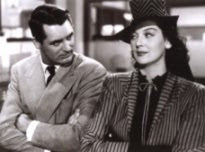The "A Secretary Is Not a Toy" number from "How to Succeed in Business Without Really Trying" - Dale Moreda recreated Bob Fosse's trademark moves for the film.
There are "dancicals," of course, a separate film form wherein characters sway, spin and skip to music but don't sing. They only dance.
Actual movie musicals, however, now routinely eliminate the moves. If you listen to the soundtrack of Alan Parker's film of "Evita" (1996), your imagination runs wild with visions of dust-raising choreography. But watch the film and the only dancing on screen is a brief waltz shared by stars Madonna and Antonio Banderas. And that's about all that Johnny Depp and Helena Bonham Carter do in Tim Burton's "Sweeney Todd: The Demon Barber of Fleet Street" (2007). (Burton not only dropped all the dances, but for some bizarre reason, also eliminated the musical's chorus as well.)
There's precious little dancing in Phyllida Lloyd's toe-tapping "Mamma Mia! (2008) and none whatsoever in Tom Hooper's funereal "Les Misérables" (2012), even though a choreographer is listed in its credits.
Gone are the days when a film musical's choreographer was as important as its, with Agnes DeMille given carte blanche by Fred Zinnemann for his version of "Oklahoma!" (1955) and Jerome Robbins translating his stage dances to film for "West Side Story" (1961).
And then there are those films whose choreographers meticulously recreated dances from the stage originals - Rod Alexander who restaged Agnes DeMille's moves for Henry King's "Carousel" (1956); Robert Tucker who traced over Jerome Robbins' choreography for Mervyn LeRoy's "Gypsy" (1962), and Dale Moreda who recreated Bob Fosse's trademark moves for David Swift's "How to Succeed in Business without Really Trying." (Hugh Lambert also contributed choreography to the stage "How to Succeed," but his contribution was not used in the film version.)



















5 comments:
I love dance on film and I appreciate that the studios went to the trouble of recreating the original Broadway choreography when the designer of those dances wasn't available.
I find that dancing in film is much more acceptable than singing. I guess that's because real people dance in real life. Even in their cars, they bop and move to music. But singing is always cause for embarrassment. Catch someone singing along to the radio in their car and they immediately clam up. We're much more self-conscious about singing than about dancing.
Frank- People are self-conscious in general, always taking their pulse, always worrying about being accepted.
I'm of two minds on film choreography. I appreciate that Fosse's dance routines for "How to Succeed" were preserved on film, even though they aren't very memorable. On the other hand, I admire Rob Marshall for eschewing the "Fosse touch," and creating his own dances for his film of "Chicago."
Dale Moreda was both a cast dancer and the dance captain in the original play, How to Succeed. He tried to recreate the original within the scope of this being a motion picture, not a staged play. He was a highly intelligent and thoughtful man, and did his best to maintain the most dance aspects of the original stage production within the requirements of a filmed production
Post a Comment